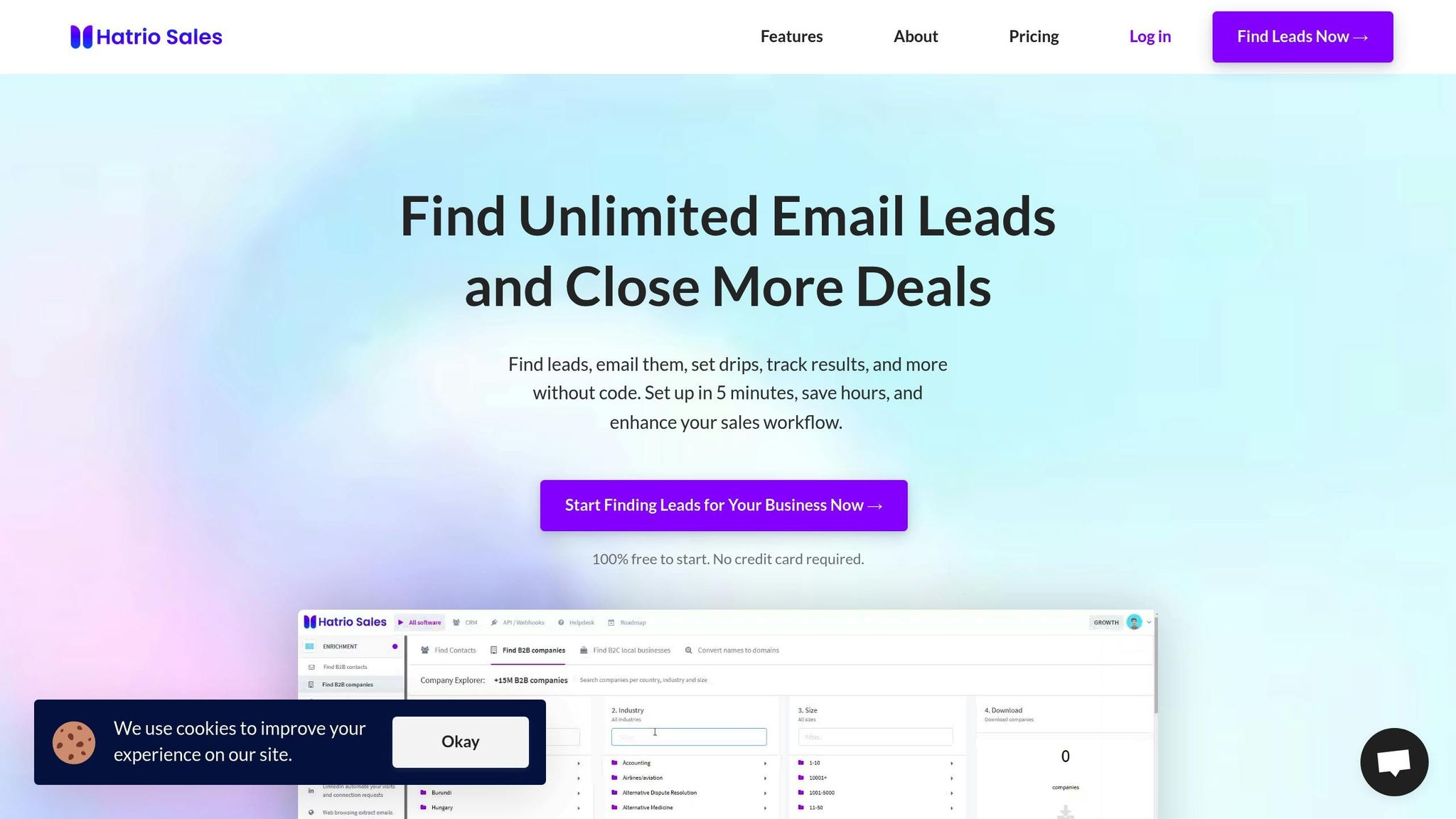Lead prioritization algorithms help sales teams focus on the best prospects by analyzing data like engagement, demographics, and behavior. Here's why they matter:
- Save Time: Automate lead scoring to focus on high-potential leads.
- Boost Conversions: Identify and prioritize leads most likely to buy.
- Real-Time Insights: Continuously update scores based on new interactions.
- Align Teams: Improve collaboration between sales and marketing with unified scoring.
Key Features of Effective Lead Scoring:
- Uses demographic, behavioral, and historical data.
- Updates scores in real time based on lead actions.
- Automates campaigns and engagement tracking.
Benefits:
- Shorter sales cycles.
- Higher close rates.
- Better use of resources.
By leveraging tools like Hatrio Sales, teams can automate lead scoring, enrich profiles, and act quickly on high-priority prospects.
Want to improve sales efficiency? Start with clean data, choose the right algorithm, and regularly refine your scoring model.
Build a Lead Scoring Model using Machine Learning in Python
Lead Prioritization Algorithm Basics
Lead prioritization algorithms turn raw lead data into practical insights. By evaluating multiple data points, these tools help sales teams identify leads most likely to convert. This ensures resources are used efficiently. Let’s break down how detailed data analysis plays a role in lead scoring.
Data Analysis for Lead Scoring
Lead scoring algorithms rely on data from several important areas:
- Demographic Data: Includes details like company size, industry, location, and revenue.
- Behavioral Data: Tracks actions such as website visits, content downloads, and email engagement.
- Historical Data: Considers past purchases, support interactions, and engagement trends.
The system assigns more weight to actions that indicate stronger buying intent. For example, downloading a pricing sheet signals more interest than casually browsing a blog post. Hatrio Sales takes this a step further by using advanced data enrichment tools to pull in extra details from various sources, building more precise profiles for prospects. This analysis supports real-time score adjustments based on fresh data.
Live Score Updates
Lead scores are updated continuously as new interactions happen. The system recalculates scores based on:
- Recent activities like form submissions or site visits
- Changes in engagement levels, such as how often or deeply a lead interacts
- Timing factors, including response delays or seasonal patterns
With Hatrio Sales' lead scoring capabilities, sales teams can track these updates in real time. This allows them to act quickly on behavior changes, ensuring high-potential leads are prioritized. As a result, sales reps can focus on building connections and closing deals efficiently.
Main Benefits for Sales Teams
Time and Resource Management
Lead prioritization algorithms help sales teams use their time and resources more efficiently. By automating lead qualification and removing the need for manual reviews, sales reps can focus on prospects most likely to convert.
Hatrio Sales streamlines this process by automating lead scoring with:
- Multi-point data evaluation
- Automated drip campaigns
- Social media engagement automation
This streamlined approach not only saves time but also helps improve conversion rates.
Higher Close Rates
Pre-qualified leads make it easier for sales teams to close deals. When efforts are focused on prospects with clear buying intent, the chances of success increase. This targeted strategy allows teams to:
- Act on strong purchase signals
- Reach out at the right time based on engagement
- Tailor their approach using detailed prospect data
- Stay consistent with follow-ups
Sales and Marketing Alignment
Lead prioritization algorithms also improve collaboration between sales and marketing teams.
- Unified Scoring Criteria: Both teams work with the same standards for evaluating leads. This ensures consistency and allows marketing to fine-tune campaigns based on what converts, while sales gains insight into the most effective marketing efforts.
- Data-Driven Feedback Loop: Sales teams share feedback on lead quality, helping marketing refine their targeting. In turn, marketing can adjust lead scoring parameters based on real sales results, creating a cycle of continuous improvement.
sbb-itb-b22f30c
Setting Up Lead Prioritization
Data Quality Requirements
For effective lead prioritization, make sure your lead database includes:
- Contact details: Verified email addresses and phone numbers.
- Company information: Details like size, industry, and location.
- Interaction history: Records of website visits, email opens, and content downloads.
- Social engagement metrics: Data on social media interactions.
- Purchase intent signals: Indicators that suggest readiness to buy.
Plan monthly cleanups to eliminate duplicates, update outdated information, and verify contact details. Once your data is clean and reliable, you can choose an algorithm that aligns with your sales process.
Algorithm Selection Guide
With quality data in place, select an algorithm that factors in both explicit and implicit signals to fine-tune lead scoring according to your sales cycle and customer behavior.
Explicit factors to consider:
- Budget authority
- Company size
- Industry alignment
- Technology stack
- Geographic location
Implicit factors to monitor:
- Depth of website engagement
- Email response rates
- Frequency of content interactions
- Social media activity
- Timing of demo or consultation requests
Hatrio Sales Integration

Hatrio Sales simplifies lead prioritization by offering built-in scoring tools. The platform enriches lead profiles with key details like company data, social media profiles, and website activity, ensuring accurate and thorough scoring.
Hatrio automates much of the process. It converts social profiles and domain names into detailed lead profiles, runs automated drip campaigns to track engagement, and updates lead scores in real time based on prospect actions. It also manages the entire sales funnel, from prospecting to closing deals.
To get started, align scoring metrics with your business objectives. Begin with basic engagement data, then refine your scoring model over time using actual conversion insights. This approach ensures continuous improvement without disrupting your sales flow.
Performance Tracking
Success Metrics
To gauge how well your lead prioritization is working, focus on these key metrics:
Conversion Rate Analysis
- Track how conversion rates vary across different lead score ranges.
- Measure the ratio of qualified leads turning into opportunities.
- Evaluate the sales cycle length for each lead segment.
Tip: Higher lead scores often correlate with shorter sales cycles and stronger conversion rates.
Response Time Metrics
- Measure the average time it takes to contact high-priority leads.
- Compare response rates across various lead score brackets.
ROI Measurements
- Calculate the cost per qualified lead.
- Assess revenue generated for each lead score segment.
- Evaluate how resources are allocated to ensure efficiency.
- Measure overall productivity of the sales team.
These metrics directly inform updates to your scoring algorithm.
Algorithm Refinement
Fine-tuning your lead scoring algorithm is crucial to keep it aligned with changing sales trends. The performance data from your metrics plays a key role in improving the model.
Optimization Actions
- Regularly review conversion trends.
- Pinpoint traits of leads that result in successful deals.
- Adjust scoring weights based on false positives.
- Incorporate behavioral signals that indicate success.
- Update scoring criteria using conversion data and new patterns.
- Eliminate or downgrade factors that prove ineffective.
- Experiment with variations in the scoring model.
The platform automatically updates scores as new data becomes available.
Review Schedule
- Check engagement metrics and basic performance weekly.
- Analyze conversion rates and scoring accuracy monthly.
- Perform a detailed algorithm review quarterly.
- Conduct a full system optimization annually.
Summary
Lead prioritization algorithms are changing how businesses identify and pursue leads. By automating the scoring and ranking process using engagement data, these tools help sales teams work more efficiently and allocate resources more effectively.
Here’s what makes lead prioritization valuable:
- Automated Qualification: Automatically analyzes lead behavior, removing the need for manual reviews.
- Better Resource Allocation: Directs attention to leads most likely to convert, boosting productivity and ROI.
- Real-Time Insights: Provides up-to-date scoring, allowing quick action on promising opportunities.
These tools enable sales teams to respond faster to top prospects, emphasizing the importance of accurate data and ongoing adjustments to the algorithm.
To make lead prioritization work for your team, focus on these key practices:
- Keep your data accurate and up-to-date.
- Regularly evaluate and tweak scoring criteria.
- Monitor performance metrics closely.
- Adjust algorithms based on what drives conversions.
FAQs
How do lead prioritization algorithms identify the best leads to pursue?
Lead prioritization algorithms use data-driven insights to rank and score leads based on their likelihood to convert into customers. These algorithms analyze various factors, such as past interactions, demographic information, behavioral patterns, and engagement levels, to determine which leads are most promising.
By focusing on high-priority leads, sales teams can allocate their time and resources more effectively, ensuring they engage with prospects who are more likely to close. Leveraging tools like Hatrio Sales, which includes advanced lead scoring and enrichment features, can significantly enhance this process and boost overall sales efficiency.
How can I make sure my lead data is accurate and ready for prioritization?
To ensure your lead data is accurate and ready for prioritization, focus on lead enrichment. This process involves enhancing your existing data by filling in gaps, verifying details, and adding valuable insights like company information or social profiles.
Using tools like those provided by Hatrio Sales, you can transform basic contact details - such as emails or domain names - into fully qualified CRM entries. Clean, enriched lead data helps your sales team prioritize effectively and close deals faster.
How can I improve my lead scoring model to keep up with changing sales trends?
To keep your lead scoring model effective, it's important to regularly update it based on new sales data and evolving customer behaviors. Hatrio Sales simplifies this process by automating lead scoring with real-time activity tracking and interest analysis. This ensures your team focuses on the most qualified and promising leads.
By leveraging tools like lead enrichment and scoring, you can fine-tune your model to align with current market trends, helping you close deals more efficiently while staying ahead in a competitive landscape.



